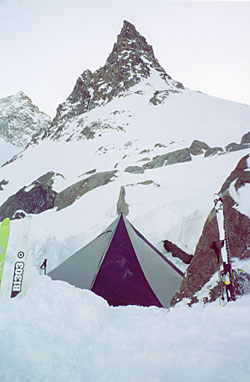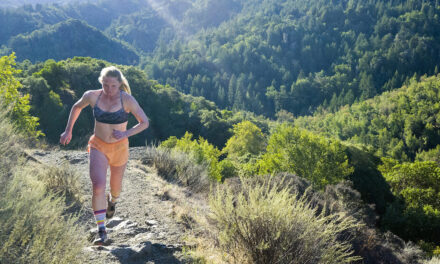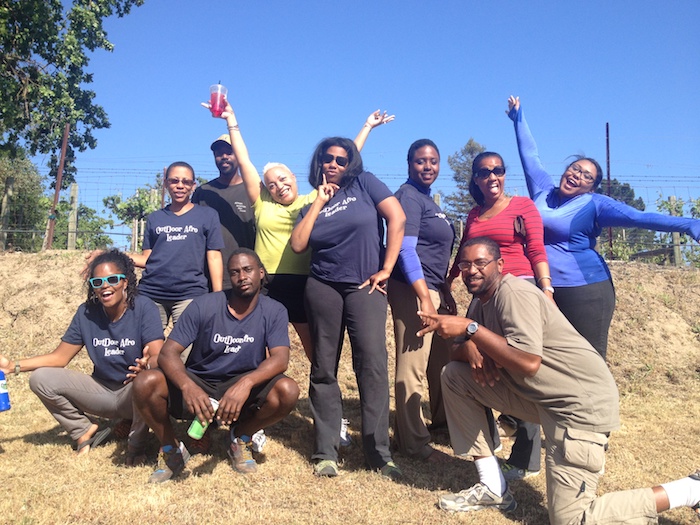- Tahoe’s Nevada Beach Tops the List of Hard-to-Book Campgrounds - 07/17/2024
- Cannabis Watershed Protection Program Cleans Up Illegal Grow Sites - 07/10/2024
- French Fire - 07/05/2024
by Michael Lanza
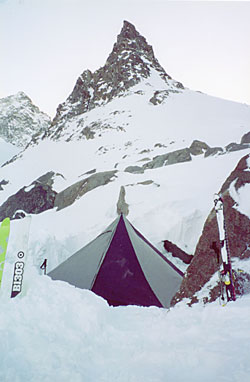
Photo: Seth Lightcap
The campsite is the focus of much of the joy of camping in the backcountry in winter. With a snow-covered ground, we have many morepotential campsites from which to choose and an opportunity for tremendous creativity in constructing our temporary living quarters. With a little skill and luck, we can enjoy an evening of rarely matched quiet and solitude and a soul-stirring view of wilderness cloaked in white. On winter’s long nights, the campsite is where we spend much of our waking time relaxing with companions, eating (and eating, and eating), and engaging in the age-old form of communication too often absent from our lives back in civilization: conversation.
Take the time to find a good campsite in winter. Given the long nights, you’ll spend many hours there, and a poorly sited camp can be uncomfortable, whereas a well-chosen site may produce the most lasting memories of the trip.
The Perfect Spot
In many respects, finding the “perfect campsite” is easier with the ground covered with snow than it is in summer: No searching for a flat spot—you can level sloping snow. No hidden rocks and roots under your pad—they’re buried. No worrying about locating near a water source—the snow all around is your water source.
That said, these are things to avoid in choosing your camp
- For starters, be aware of and respect all backcountry camping regulations, and know how to recognize and avoid avalanche hazard in the mountains.
- If you like the view from an exposed ridge or mountaintop, be sure
you’re confident of a calm night, because those spots tend to get buffeted by strong winds that can damage your tent or keep you awake all night. - Whenever possible, pitch your tent out of the wind, or with its lower end pointing into the wind and the door away from the wind. Sometimes it’s possible to camp on the lee side of a broad ridge without getting
onto a slope that could possibly avalanche and enjoy a nice view without getting hammered by wind. - Avoid the lowest ground in the area, such as a valley bottom—the coldest air will settle there overnight. Atop a knoll protected by trees is best.
- Consider your campsite in the context of a storm: Will you be able to leave safely if a lot of snow fell overnight and slopes at certain angles and aspects suddenly became prone to avalanche?If there’s any concern about animals raiding your food, identifying a proper spot for overnight food storage (such as a tree with a good branch for bear-bagging) should be a priority in selecting your campsite.
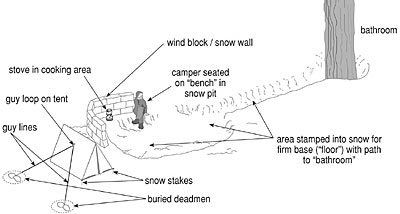
Illustration 10-1. The complete winter campsite features a firm platform stomped into the snow; a path stomped to the “bathroom”; a cooking area protected from the wind by a snow wall; and a tent secured by guy lines, stakes and deadmen.
Making Camp
Once you’ve selected a campsite, the real work—and creativity—begins. How you set up camp will affect the rest of your time there. Think about the type of camp you want and how to make it comfortable, given your environment.
Some ideas for camping with a tent follow:
- At the outset, unless the snow underfoot is firm enough to support your
weight without postholing in, you’ll have to stomp out a snow platform. Wearing your skis or snowshoes, walk back and forth across an area big enough for your tent plus surrounding area where you want to walk in boots or booties (that is, without putting on snowshoes or skis)—usually, an area about twice the foot-print of your tent. During this time, also stomp out a path to your designated “bathroom” (usually a tree or trees nearby) and your food-storage spot, if the latter will be separate from your campsite. - In dry powder it can take an hour or more of stomping and waiting for the snow to firm up before it holds your weight without skis or snowshoes. But the snow will eventually firm up and freeze into a solid platform, unless you’re in unbonded “sugar” snow, which resembles its nickname and resists packing into snowballs or a firm platform. If that’s the case, you might want to relocate. Although sugar snow can cover a large area, sometimes getting to a spot with a different aspect, snow depth, or exposure to sun and wind will yield better snow.
- Build a snow wall on the upwind side of your tent as a windbreak or all around your tent if the wind could shift (Illustrations 10-1 and 10-2). It has to be close to the tent to be effective. If winds are severe and you cannot find a spot protected from them, dig out a tent site a couple feet down into the snow before you begin stomping a platform; this will give you more of a snow wall on all sides as a shield against the wind.
- Excavate a living room/kitchen in the snow outside your tent door that’s big enough for everyone to sit inside (depending on circumstances, this may be immediately outside your door or a short distance
away in a spot that’s either more protected or has a better view). - Immediately outside your tent door or vestibule door cut down 12 to 18 inches into the snow to create a step where you can sit to put on boots or just sit partly protected by the tent.
- Mark off in the snow the area for the living room/kitchen. Measuring about a foot in from its edges, dig down a foot or two (how deep you go depends on how hard you want to work vs. how much protection from wind you’re seeking) to create a bench around the pit’s perimeter. Then dig out the pit’s interior floor, about a foot deeper than the bench.
- Build a snow windbreak on the upwind side of the pit.
- Customize other features such as a cooking surface on the bench or rim of the living room/kitchen, including a snow windbreak for your stove, and small “cabinets” dug into the walls of the pit for storing cooking gear and—-if there’s no concern about animals—food.
- This is an excerpt from the book Winter Hiking and Camping: Managing Cold For Comfort and Safety by Michael Lanza. The book is published by The Mountaineers Books.
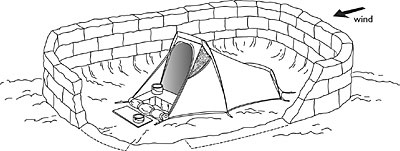
Illustration 10-2. When camping in strong wind, encircle your tent with a snow wall and pitch your tent with its foot facing into the prevailing wind so you can cook in the lee of your tent while lying inside, out of the wind.

